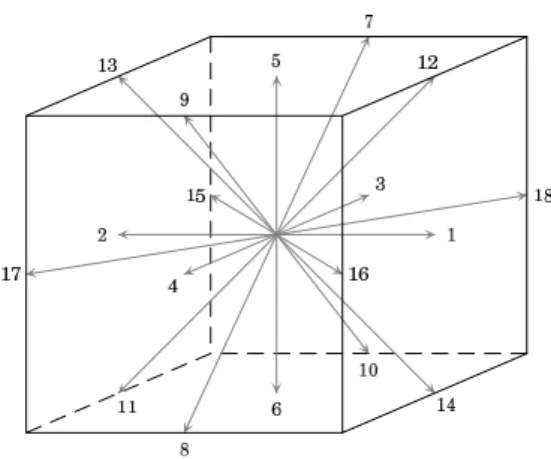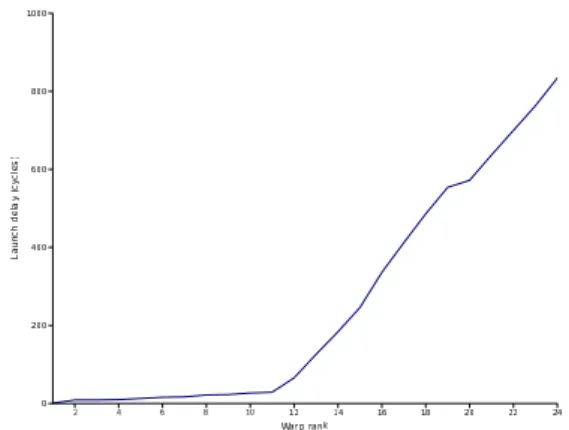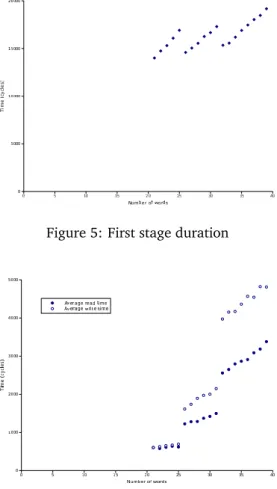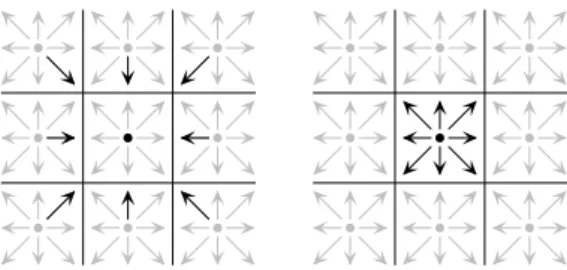HAL Id: hal-01003059
https://hal.archives-ouvertes.fr/hal-01003059
Submitted on 9 Jun 2014
HAL is a multi-disciplinary open access
archive for the deposit and dissemination of
sci-entific research documents, whether they are
pub-lished or not. The documents may come from
teaching and research institutions in France or
L’archive ouverte pluridisciplinaire HAL, est
destinée au dépôt et à la diffusion de documents
scientifiques de niveau recherche, publiés ou non,
émanant des établissements d’enseignement et de
recherche français ou étrangers, des laboratoires
Global Memory Access Modelling for Efficient
Implementation of the LBM on GPUs
Christian Obrecht, Frederic Kuznik, Bernard Tourancheau, Jean-Jacques
Roux
To cite this version:
Christian Obrecht, Frederic Kuznik, Bernard Tourancheau, Jean-Jacques Roux. Global Memory
Ac-cess Modelling for Efficient Implementation of the LBM on GPUs. Lecture Notes in Computer Science,
Springer, 2011, 6449, pp.151-161. �hal-01003059�
of the Lattice Boltzmann Method on Graphics Processing Units
Christian Obrecht
∗,1, Frédéric Kuznik
1, Bernard Tourancheau
2, and Jean-Jacques Roux
11
Centre de Thermique de Lyon (UMR 5008 CNRS, INSA-Lyon, UCB Lyon1),
69621 Villeurbanne Cedex, France
2
Laboratoire de l’Informatique du Parallélisme (UMR 5668 CNRS, ENS-Lyon, INRIA,
UCB Lyon 1), 69364 Lyon Cedex 07, France
Published in Lecture Notes in Computer Science 6449, High Performance Computing for
Computational Science – VECPAR 2010 Revised Selected Papers, pages 151–161,
February 2011
Abstract
In this work, we investigate the global memory ac-cess mechanism on recent GPUs. For the purpose of this study, we created specific benchmark programs, which allowed us to explore the scheduling of global memory transactions. Thus, we formulate a model capable of estimating the execution time for a large class of applications. Our main goal is to facilitate optimisation of regular data-parallel applications on GPUs. As an example, we finally describe our CUDA implementations of LBM flow solvers on which our model was able to estimate performance with less than 5% relative error.
Keywords: GPU computing, CUDA, lattice
Boltz-mann method, CFD
Introduction
State-of-the-art graphics processing units (GPU) have proven to be extremely efficient on regular data-parallel algorithms [3]. For many of these applica-tions, like lattice Boltzmann method (LBM) fluid flow solvers, the computational cost is entirely hidden by global memory access. The present study intends to give some insight on the global memory access mech-anism of the nVidia’s GT200 GPU. The obtained
re-∗Corresponding author:christian.obrecht@insa-lyon.fr
sults led us to optimisation elements which we used for our implementations of the LBM.
The structure of this paper is as follows. First, we briefly review nVidia’s compute unified device archi-tecture (CUDA) technology and the algorithmic as-pects of the LBM. Then, we describe our measure-ment methodology and results. To conclude, we present our CUDA implementations of the LBM.
1
Compute Unified Device
Archi-tecture
CUDA capable GPUs, i.e. the G8x, G9x, and GT200 processors consist in a variable amount of texture processor clusters (TPC) containing two (G8x, G9x) or three (GT200) streaming multiprocessors (SM), texture units and caches [6]. Each SM contains eight scalar processors (SP), two special functions units (SFU), a register file, and shared memory. Regis-ters and shared memory are fast but in rather lim-ited amount, e.g. 64 KB and 16 KB per SM for the GT200. On the other hand, the off-chip global mem-ory is large but suffers from high latency and low throughput compared to registers or shared memory. The CUDA programming language is an extension to C/C++. Functions intended for GPU execution are named kernels, which are invoked on an execu-tion grid specified at runtime. The execuexecu-tion grid is
C. Obrecht, F. Kuznik, B. Tourancheau, and J.-J. Roux
formed of blocks of threads. The blocks may have up to three dimensions, the grid two. During execution, blocks are dispatched to the SMs and split into warps of 32 threads.
CUDA implementations of data intensive applica-tions are usually bound by global memory through-put. Hence, to achieve optimal efficiency, the number of global memory transactions should be minimal. Global memory transactions within a half-warp are coalesced into a single memory access whenever all the requested addresses lie in the same aligned seg-ment of size 32, 64, or 128 bytes. Thus, improving the data access pattern of a CUDA application may dramatically increase performance.
2
Lattice Boltzmann Method
The Lattice Boltzmann Method is a rather innovative approach in computational fluid dynamics [5,11,2]. It is proven to be a valid alternative to the numeri-cal integration of the Navier-Stockes equations. With the LBM, space is usually represented by a regular lattice. The physical behaviour of the simulated fluid is determined by a finite set of mass fractions associ-ated to each node. From an algorithmic standpoint, the LBM may be summarised as:
for each time step do for each lattice node do
if boundary node then
apply boundary conditions
end if
compute new mass fractions propagate to neighbouring nodes
end for end for
The propagation phase follows some specific sten-cil. Figure1 illustrates D3Q19, the most commonly used three-dimensional stencil, in which each node is linked to 18 of its 27 immediate neighbours.1
1Taking the stationary mass fraction into account, the number
of mass fractions per node amounts to 19, hence D3Q19.
Figure 1: The D3Q19 stencil
CUDA implementations of the LBM may take ad-vantage of its inherent data parallelism by assign-ing a thread to each node, the data beassign-ing stored in global memory. Since there is no efficient global synchronisation barrier, a kernel has to be invoked for each time step [12]. CPU implementations of the LBM usually adopt an array of structures (AoS) data layout, which improves locality of mass frac-tions belonging to a same node [10]. On the other hand, CUDA implementations benefit from structure of arrays (SoA) data layouts, which allows coalesced global memory accesses [4]. However, this approach is not sufficient to ensure optimal memory trans-actions, since propagation corresponds to one unit shifts of global memory addresses for the minor spa-tial dimension. In other words, for most mass frac-tions, the propagation phase yields misalignments. A way to solve this issue consists in performing prop-agation partially in shared memory [13]. Yet, as shown in [7], this approach is less efficient than us-ing carefully chosen propagation schemes in global memory.
3
Methodology
To study transactions between global memory and registers, we used kernels performing the following operations :
1. Store time t0in a register.
2. Read N words from global memory, with possi-bly L misalignments.
4. Write N words to global memory, with possibly
M misalignments.
5. Store time t2in a register.
6. Write t2to global memory.
Time is accurately determined using the CUDA
clock()
function which gives access to countersthat are incremented at each clock cycle. Our ob-servations enabled us to confirm that these counters are per TPC, as described in [8], and not per SM as stated in [6]. Step 6 may influence the timings, but we shall see that it can be neglected under certain circumstances.
The parameters of our measurements are N , L, M , and k, the number of warps concurrently assigned to each SM. Number k is proportional to the occu-pancy rate α, which is the ratio of active warps to the maximum number of warps supported on one SM. With the GT200, this maximum number being 32, we have: k = 32α.
We used a dimensional grid and one-dimensional blocks containing one single warp. Since the maximum number of blocks supported on one SM is 8, the occupancy rate is limited to 25%. Nonethe-less, this rate is equivalent to the one obtained with actual CUDA applications.
We chose to create a script generating the ker-nels rather than using runtime parameters and loops, since the layout of the obtained code is closer to the one of actual computation kernels. We processed the CUDA binaries using decuda [14] to check whether the compiler had reliably translated our code. We carried out our measurements on a GeForce GTX 295 graphics board, featuring two GT200 processors.2
4
Modelling
At kernel launch, blocks are dispatched to the TPCs one by one up to k blocks per SM [1]. Since the GT200 contains ten TPCs, blocks assigned to the same TPC have identical
blockIdx.x
unit digit. This enables to extract information about the scheduling of global memory access at TPC level. In order to compare the measurements, as the clock reg-isters are peculiar to each TPC [8], we shifted the2In the CUDA environment, the GPUs of the GTX 295 are
con-sidered as two distinct devices. It should be noted that our bench-mark programs involve only one of those devices.
origin of the time scale to the minimal t0. We
no-ticed that the obtained timings are coherent on each of the TPCs.
For a number of words read and written N ≤ 20, we observed that:
• Reads and writes are performed in one stage, hence storing of t2has no noticeable influence.
• Warps 0 to 8 are launched at once (in a deter-mined but apparently incoherent order).
• Subsequent warps are launched one after the other every ∼ 63 clock cycles.
For N > 20, reads and writes are performed in two stages. One can infer the following behaviour: if the first n warps in a SM read at least 4,096 words, where
n ∈ {4, 5, 6}, then the processing of the subsequent
warps is postponed. The number of words read by the first n warps being n× 32N , this occurs whenever
n × N ≥ 128. Hence, n = 4 yields N ≥ 32, n = 5
yields N ≥ 26, and n = 6 yields N ≥ 21.
Time t0 for the first 3n warps of a TPC follow the same pattern as in the first case. We also no-ticed a slight overlapping of the two stages, all the more as storing t2should here be taken into account. Nonetheless, the read time for the first warp in the second stage is noticeably larger than for the next ones. Therefore, we may consider, as a first approx-imation, that the two stages are performed sequen-tially.
In the targeted applications, the global amount of threads is very large. Moreover, when a set of blocks is assigned to the SMs, the scheduler waits until all blocks are completed before providing new ones. Hence, knowing the average processing time
T of k warps per SM allows to estimate the global
execution time.
For N ≤ 20, we have T = ℓ + TR+ TW, where ℓ is time t0for the last launched warp, TR is read time,
and TW is write time. Time ℓ only depends on k. For
N > 20, we have T = T0+ℓ′+TR′+T
′
W, where T0is the
processing time of the first stage, ℓ′(i) = ℓ(i − 3n + 9) with i = 3k − 1, TR′ and TW′ are read and write times for the second stage.
C. Obrecht, F. Kuznik, B. Tourancheau, and J.-J. Roux
Figure 2: Launch delay in respect of warp rank
To estimate ℓ, we averaged t0over a large number
of warps. Figure 2 shows, in increasing order, the obtained times in cycles. Numerically, we have ℓ(i) ≈ 0 for i ≤ 9 and ℓ(i) ≈ 63(i − 10) + 13 otherwise.
5
Throughput
5.1
N ≤ 20
Figures 3 and 4 show the distribution of read and write times for 96,000 warps with N = 19. The bi-modal shape of the read time distribution is due to translation look-aside buffer (TLB) misses [15]. This aspect is reduced when adding misalignments, since the number of transactions increases while the num-ber of misses remains constant. Using the average read time to approximate T is acceptable provided no special care is taken to avoid TLB misses.
Figure 3: Read time for N = 19
Figure 4: Write time for N = 19
We observed that average read and write times de-pend linearly of N . Numerically, with k = 8, we ob-tained:
TR≈ 317(N − 4) + 440 TW≈ 562(N − 4) + 1,178
TR′≈ 575(N −4)+291 TW′≈ 983(N −4)+2,030
where TR′ and TW′ are read and write times with L = N and M = N misalignments. Hence, we see that
writes are more expensive than reads. Likewise, alignments in writes are more expensive than mis-alignments in reads.
5.2
21 ≤ N ≤ 39
As shown in figures 5 and 6, T0, TR′, and TW′ de-pend linearly of N in the three intervals {21, . . . 25}, {26, . . . 32}, and {33, . . . 39}. As an example, for the third interval, we obtain:
T0≈ 565(N − 32) + 15,164
Figure 5: First stage duration
Figure 6: Timings in second stage
5.3
Complementary studies
We also investigated the impact of misalignments and occupancy rate on average read and write times. Fig-ures7and8show obtained results for N = 19.
Figure 7: Misaligned reads
For misaligned reads, we observe that the average write time remains approximatively constant. Read time increases linearly with the number of misalign-ments until some threshold is reached. From then on, the average read time is maximal. Similar conclusion can be drawn for misaligned writes.
Figure 8: Occupancy impact
Average read and write times seem to depend quadratically on k. Since the amount of data trans-ferred depends only linearly on k, this leads to think that the scheduling cost of each warp is itself propor-tional to k.
6
Implementations
We implemented several LBM fluid flow solvers: a D3Q19 LBGK [11], a D3Q19 MRT [2], and a dou-ble population thermal model requiring 39 words per node [9]. Our global memory access study lead us to multiple optimisations. For each implementation, we used a SoA like data layout, and a two-dimensional grid of one-dimensional blocks. Since misaligned writes are more expensive than misaligned reads, we experimented several propagation schemes in which misalignments are deferred to the read phase of the next time step. The most efficient appears to be the reversed scheme where propagation is entirely performed at reading, as outlined in figure 9. For the sake of simplicity, the diagram shows a two-dimensional version.
C. Obrecht, F. Kuznik, B. Tourancheau, and J.-J. Roux
Figure 9: Reversed propagation scheme
Performance of a LBM based application is usu-ally given in million lattice node updates per second (MLUPS). Our global memory access model enables us to give an estimate of the time T (in clock cycles) required to process k warps per SM. On the GT200, where the number of SMs is 30 and the warp size is 32, k warps per SM amounts to K = 30 × k × 32 = 960k threads. Since one thread takes care of one sin-gle node, T is therefore the number of clock cycles needed to perform K lattice node updates. Hence, using the global memory frequency F in MHz, the expected performance in MLUPS is: P = (K/T ) × F .
With our D3Q19 implementations, for instance, we have N = 19 reads and writes, L = 10 mis-aligned reads, no mismis-aligned writes, and 25% occu-pancy (thus k = 8). Using the estimation provided by our measurements, we obtain: T = ℓ + TR+ TW= 15,594. Since K = 7,680 and F = 999 MHz, we have
P = 492 MLUPS.
To summarize, table1 gives both the actual and estimated performances for our implementations on a 1283 lattice. Our estimations appear to be rather accurate, thus validating our model.
Summary and discussion
In this work, we present an extensive study of the global memory access mechanism between global memory and GPU for the GT200. A description of the scheduling of global memory accesses at hard-ware level is given. We express a model which al-lows to estimate the global execution time of a regu-lar data-parallel application on GPU. The cost of in-dividual memory transactions and the impact of mis-alignments is investigated as well.
We believe our model is applicable to other GPU applications provided certain conditions are met:
• The application should be data-parallel and use
a regular data layout in order to ensure steady data throughput.
• The computational cost should be negligible as compared with the cost of global memory reads and writes.
• The kernel should make moderate use of branching in order to avoid branch divergence, which can dramatically impact performance. This would probably not be the case with an application dealing, for instance, with complex boundaries.
On the other hand, our model does not take pos-sible TLB optimisation into account. Hence, some finely tuned applications may slightly outvalue our performance estimation.
The insight provided by our study, turned out to be useful in our attempts to optimize CUDA imple-mentations of the LBM. It may contribute to efficient implementations of other applications on GPU.
References
[1] S. Collange, D. Defour, and A. Tisserand. Power Consumption of GPUs from a Software Perspec-tive. In Lecture Notes in Computer Science 5544,
Proceedings of the 9th International Conference on Computational Science, Part I, pages 914–
923. Springer, 2009.
[2] D. d’Humières, I. Ginzburg, M. Krafczyk, P. Lallemand, and L.S. Luo. Multiple-relaxation-time lattice Boltzmann models in three dimen-sions. Philosophical Transactions of the Royal
So-ciety A, 360:437–451, 2002.
[3] J. Dongarra, G. Peterson, S. Tomov, J. Allred, V. Natoli, and D. Richie. Exploring new archi-tectures in accelerating CFD for Air Force appli-cations. In DoD HPCMP Users Group Conference, pages 472–478. IEEE, 2008.
[4] F. Kuznik, C. Obrecht, G. Rusaouën, and J.-J. Roux. LBM Based Flow Simulation Using GPU Computing Processor. Computers and Math-ematics with Applications, 59(7):2380–2392,
Model Occupancy Actual Estimated Relative error
D3Q19 LBGK 25% 481 492 2.3%
D3Q19 MRT 25% 516 492 4.6%
Thermal LBM 12.5% 195 196 1.0%
Table 1: Performance of LBM implementations (in MLUPS)
[5] G. R. McNamara and G. Zanetti. Use of the Boltzmann Equation to Simulate Lattice-Gas Automata. Physical Review Letters,
61(20):2332–2335, 1988.
[6] NVIDIA. Compute Unified Device Architecture
Programming Guide version 2.3.1, 2009.
[7] C. Obrecht, F. Kuznik, B. Tourancheau, and J.-J. Roux. A New Approach to the Lattice Boltz-mann Method for Graphics Processing Units.
Computers and Mathematics with Applications,
61(12):3628–3638, 2011.
[8] M.M. Papadopoulou, M. Sadooghi-Alvandi, and H. Wong. Micro-benchmarking the GT200 GPU. Technical report, University of Toronto, Canada, 2009.
[9] Y. Peng, C. Shu, and Y. T. Chew. A 3D incom-pressible thermal lattice Boltzmann model and its application to simulate natural convection in a cubic cavity. Journal of Computational Physics, 193(1):260–274, 2004.
[10] T. Pohl, M. Kowarschik, J. Wilke, K. Iglberger, and U. Rüde. Optimization and Profiling of the Cache Performance of Parallel Lattice Boltzmann Codes. Parallel Processing Letters, 13(4):549–560, 2003.
[11] Y. H. Qian, D. d’Humières, and P. Lallemand. Lattice BGK models for Navier-Stokes equa-tion. EPL (Europhysics Letters), 17(6):479–484, 1992.
[12] S. Ryoo, C. I. Rodrigues, S. S. Baghsorkhi, S. S. Stone, D. B. Kirk, and W. W. Hwu. Optimization principles and application performance evalua-tion of a multithreaded GPU using CUDA. In
Proceedings of the 13th ACM SIGPLAN Sympo-sium on Principles and practice of parallel pro-gramming, pages 73–82. ACM, 2008.
[13] J. Tölke and M. Krafczyk. TeraFLOP computing on a desktop PC with GPUs for 3D CFD.
Interna-tional Journal of ComputaInterna-tional Fluid Dynamics,
22(7):443–456, 2008.
[14] W. J. van der Laan. Decuda G80 dis-sassembler version 0.4. Available on
www.github.com/laanwj/decuda, 2007. [15] V. Volkov and J.W. Demmel. Benchmarking
GPUs to tune dense linear algebra. In
Proceed-ings of the 2008 ACM/IEEE Conference on Super-computing. IEEE, 2008.




![Table 1: Performance of LBM implementations (in MLUPS) [5] G. R. McNamara and G. Zanetti](https://thumb-eu.123doks.com/thumbv2/123doknet/14644402.735741/8.892.138.713.191.296/table-performance-lbm-implementations-mlups-g-mcnamara-zanetti.webp)